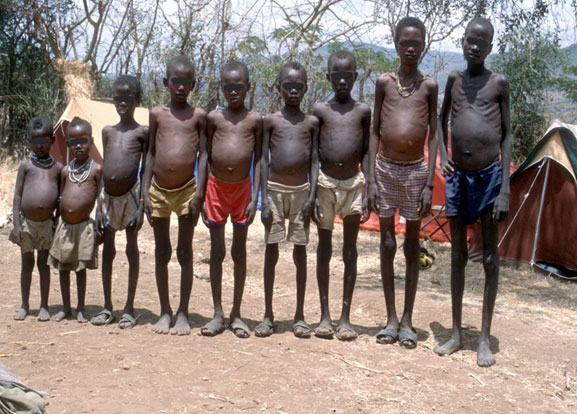


About THE PROJECTVisceral leishmaniasis (VL) known as Kala-Azar is a very serious disease caused by Leishmania donovani parasites. An estimated 500,000 VL cases occur annually, mostly in India, East Africa and Brazil. In Africa, the worst affected regions are southern Sudan, with estimated 15,000-20,000 cases annually and Ethiopia with 4,000-5,000 diagnosed VL cases a year. Kala-Azar is considered an emerging disease in Ethiopia where it is frequently associated with AIDS, a leading cause of adult illness and death in that country. Untreated, Kala-Azar is usually fatal, but with appropriate treatment patients can recover.
Children with Visceral Leishmaniasis – South Ethiopia Aims of the project include: To study the ecology, population dynamics and behavior of the sand fly vectors of VL in relation to seasonal and nocturnal activities of villagers. To identify and characterize productive sand fly larval breeding habitats. To determine which populations comprise significant sources of infection for sand flies (xenodiagnosis). Is zoonotic transmission important for maintaining the disease? To characterize L. donovani causing distinct pathologies and determine parasite sensitivity/resistance to different drugs. To formulate mathematical models for analyzing long-term quantitative data on parasites, vectors, reservoir hosts and human patients. In order to attain these goals, thorough investigations of the ecology and epidemiology of Kala-Azar will tease apart the transmission cycle of the disease in Ethiopian foci. Long-term studies will quantify the relative contribution of different drivers of transmission (ecological, epidemiological and anthropogenic factors) to the overall impact of the disease on human populations. Sand flies are collected using a variety of techniques in order to determine the transmission seasons and the timing of peak sand fly activity. Additional questions to be addressed include: Where are the sand flies coming from and from how far away? What are their preferred blood sources (humans, cows, dogs, other)? What are the main larval breeding habitats? Are they found in any particular soil types (vertisol)? Is sand fly breeding restricted to forest and woodland? Are they affected by agricultural soil management practices (sesame or sorghum)? Is there correlation with organic matter content and other soil characteristics such as mechanical and mineralogical composition, redox potential and ratios of exchangeable cations? Do physical features suchasaggregate stability, deep cracks, water content, play a role? What are the significant parasite reservoirs for infection of sand flies - human or animal? What are the human populations comprising the significant reservoirs of the disease (VL/ PKDL patients, asymptomatic carriers, VL-HIV coinfected)? Do animal reservoir hosts contribute significantly to the transmission cycles and if so, which species? These questions are being addressed using diverse field and laboratory techniques. The acquired information will be thoroughly analyzed using state of the art statistical tools. Mathematical models will be formulated to assist in experimental design that will make possible the incrimination of “key” elements in the transmission cycles, those likely to constitute targets for future control campaigns. |

Site by: eleanor.co.il | Last updated: August 31, 2011 | This site is graciously hosted by The Hebrew University of Jerusalem






